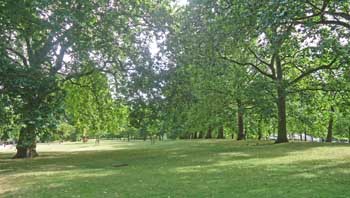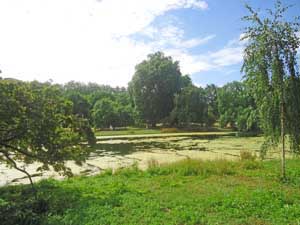Open Air School
Open Air School
A small open air school was set up by the LCC around 1918 within the grounds of St James's Park. This was one of the very few examples of private use of facilities within a Royal Park - at least until our present entrepreneurial environment.
The School was located in an enclosure at
the southwest part of the Park opposite the Wellington
Barracks, close to
Buckingham Palace. It accommodated about 60 pupils
of both sexes aged from 7 to 14 years (11 was the average age)
who had been selected from 20 schools in the City and Westminster.
They were all from poor families and most of them were delicate
or predisposed to tubercular tendencies, with coughs and night sweats.
They were divided into classes according to ability rather than
age. Some were weak and under doctor's orders not to have the
strain of the full School course.
The wives of local residents formed a rota to provide hot soup for the children during their breaks. Blankets and hot milk were also welcome during the winter terms - even for the school mascot dog, Chum. Mrs Baldwin, the wife of the Prime Minister, Stanley Baldwin, took a keen interest in the School, and even provided access to windows in No. 10 Downing Street for the children to watch the Trooping of the Colour ceremony.
All lessons were held outside but, in particularly bad weather, the hut was used as a classroom, where there was always a free circulation of air. Some children arrived in overcoats, hats and gloves in cold weather, but as their health improved, these were soon discarded and draped over the backs of their chairs.
The two schoolmistresses organised teaching activities near the Park's lake (the local ducks were known to join in the classes on occasion). Flowers and leaves from the trees were used as models for drawing classes. The park authorities provided special facilities for the children's botany studies.
The morning classes consisted of reading, arithmetic, nature study, composition or history. Every half-an-hour there was a break for physical exercise and, at 10.30, a break for a glass of milk or hot soup. At noon the children trooped off to St Margaret's National School in Dean Farrar Street for a hot meal of two courses.
At 1 o'clock the children returned to their School and carried out their beds and blankets from the hut to bushes and sheltered nooks within their enclosure. They then went to sleep for one hour. At first new children were restless and had to be ordered to close their eyes and lie still; they soon learned to relax.
At 2 o'clock they were firmly awakened so they would not spoil their night's rest later. The afternoon was spent on handwork (needlework, mat-making, etc), drawing and painting, acting, musical appreciation or other lessons prescribed by the LCC's curriculum.
The school day ended at 3.30, when the children returned home.
The School continued in operation until 1939. On the outbreak of WW2 that year, the School was closed. It was never re-established.
Present status (July 2013)
In such a conveniently central location, the School seems to have attracted journalists, and a number of photos have survived, along with various feature articles. However, it is not recorded on contemporary maps.
Because it had no permanent buildings, just a tented hut, and carried out its classes under the skies, it is not surprising that no physical evidence of its existence remains on the ground.

The southwest part of the Park opposite the Guards' Barracks.

The lake in the Park is covered in algae during the hot summer of 2013.
(Author unstated) 1936 A mouth organ band. Singapore Free Press and Mercantile Advertiser, 27th March, 6.
Keating T 1934 "C3" children. London's schools. Lessons out of doors. Sydney Morning Herald, 10th July, 4.
Montizambert E 1928 Gazette's Budget of London Topics. Montreal Gazette, 18th August, 24.
Yeats-Brown F 1927 The Open Air School in St James's Park. The Spectator, 16th November, 7.
http://ah.brookes.ac.uk
http://arts.guardian.co.uk
http://collage.cityoflondon.gov.uk
http://hansard.millbanksystems.com
http://img.pars03.fr.topfoto.co.uk
www.calmview.en
www.facebook.com
www.gettyimages.co.uk (1)
www.gettyimages.co.uk (2)
www.scienceandsociety.co.uk
www3.westminster.gov.uk
Return to alphabetical list
Return to home page